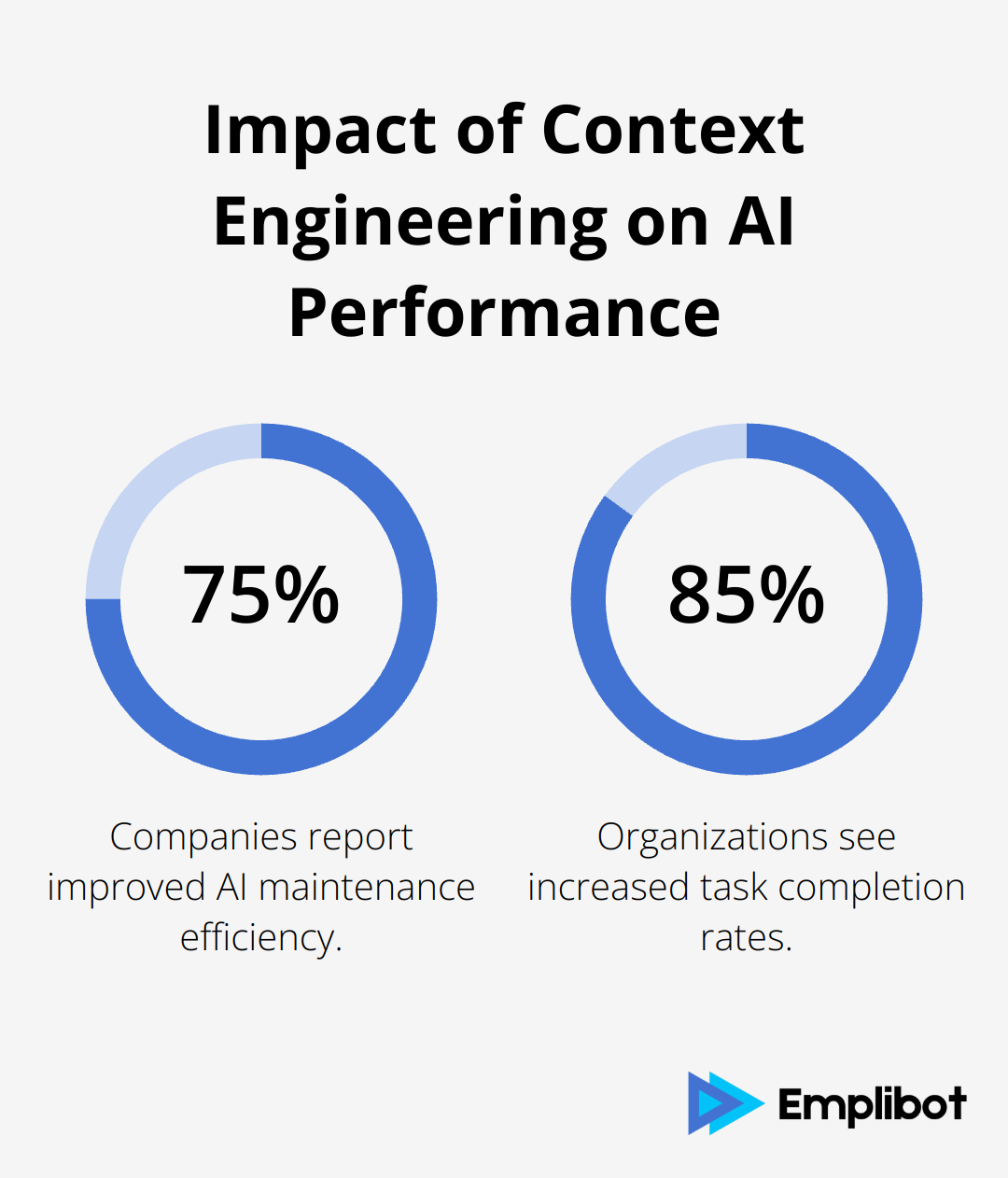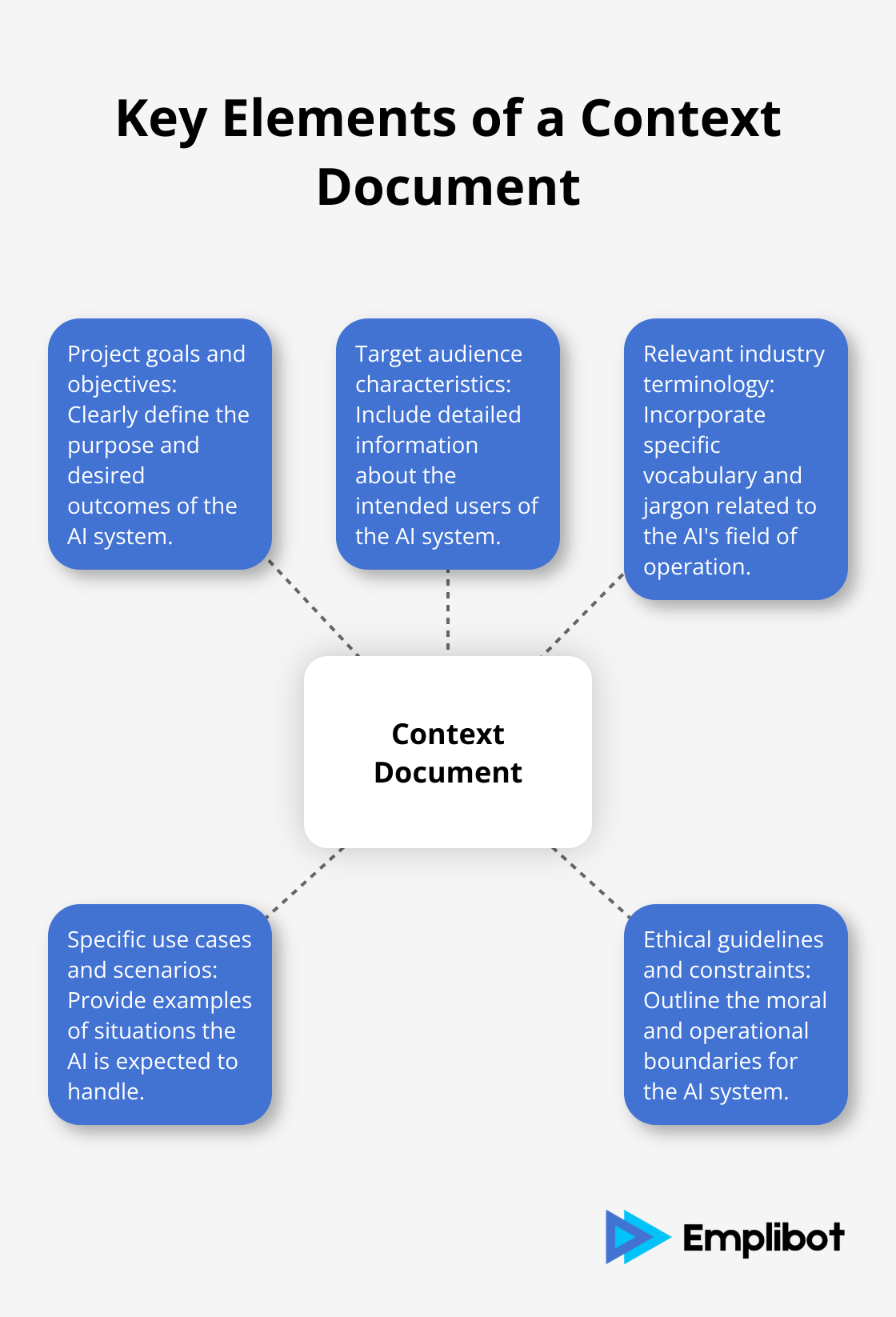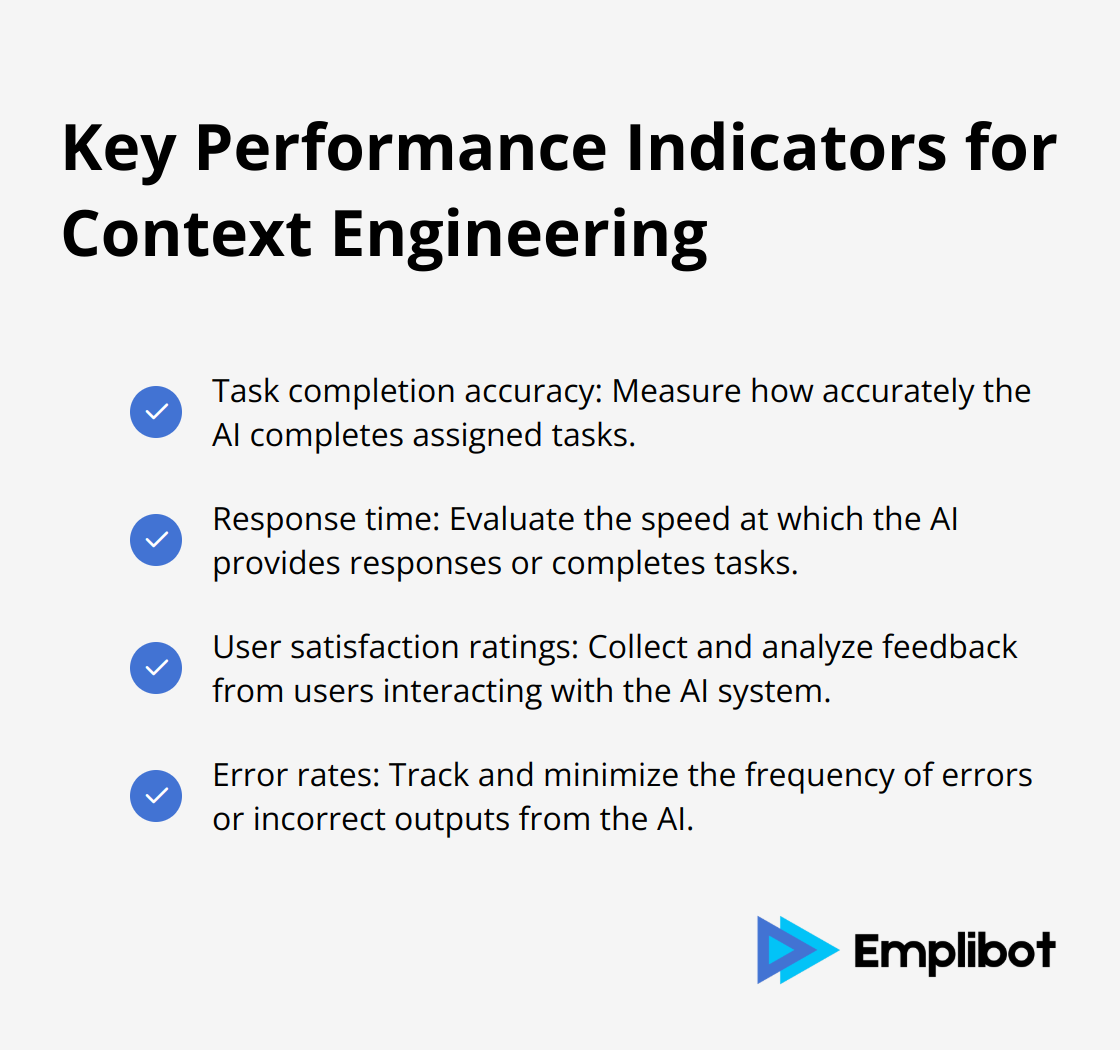At Emplibot, we’ve witnessed a seismic shift in AI development. Context engineering for AI has emerged as the new standard, replacing outdated prompt engineering techniques.
This guide will show you how to master context engineering, providing practical steps and actionable insights. We’ll explore its implementation in AI systems and discuss its far-reaching implications for the future of artificial intelligence.
Contents
ToggleWhy Context Engineering Matters
The Evolution of AI Interaction
Context engineering has revolutionized AI interaction. This approach provides AI models with comprehensive, relevant information to enhance their understanding and performance. It creates a rich environment for AI to operate within, surpassing simple prompts.
The Obsolescence of Prompt Engineering
Prompt engineering, once the primary method for guiding AI responses, has become outdated. Its limitations are evident:
- It relies on crafting perfect instructions for each interaction
- It proves time-consuming and often ineffective for complex tasks
- It fails to produce consistent results in multi-step AI interactions
Context Engineering: A Superior Approach
Context engineering addresses these shortcomings by focusing on the bigger picture. Instead of relying on individual prompts, it creates an information framework for the AI to draw from. This approach leads to more accurate, consistent, and contextually appropriate responses.
Real-World Applications
Context engineering improves AI performance across various domains:
- Content Generation: AI systems consider brand voice, industry trends, and target audience demographics
- Customer Service: By providing AI with a comprehensive understanding of a company’s products, policies, and customer history, response accuracy improves
Implementing Context Engineering
To start with context engineering, focus on creating detailed knowledge bases for your AI systems. This includes:
- Compiling relevant data sources
- Structuring information in easily digestible formats
- Regularly updating and refining the context based on new information and feedback
Companies that have adopted context engineering report improvements in AI maintenance and task completion rates, according to the 2025 AI Index Report.

The Future of AI Development
Context engineering represents more than a trend; it sets the new standard for AI development. This approach unlocks the full potential of AI systems, leading to more efficient operations and improved user experiences.
As we move forward, the next logical step is to explore the practical steps involved in context engineering. Let’s examine how to gather and organize relevant information, create comprehensive context documents, and refine our approach for optimal results.
How to Master Context Engineering
Building Your Knowledge Base
Context engineering starts with a robust knowledge base. Identify all relevant data sources for your AI application, including industry reports, academic papers, company documentation, and user feedback. A financial AI system, for example, should incorporate market trends, economic indicators, and regulatory guidelines.
Organize this information into a structured database. Use tagging systems and metadata to make the information easily searchable and retrievable. This step ensures that your AI can quickly access the right information when needed.
Crafting the Perfect Context Document
A well-crafted context document provides a comprehensive overview of the AI’s operational environment. Include key information such as:
- Project goals and objectives
- Target audience characteristics
- Relevant industry terminology
- Specific use cases and scenarios
- Ethical guidelines and constraints
Be concise yet thorough. Avoid ambiguity and use clear, precise language. This document will guide your AI’s decision-making process.

Refining Your Context
Context engineering requires continuous improvement. Analyze your AI’s performance regularly and refine your context accordingly. Use A/B testing to compare different context versions and their impact on AI outputs.
Implement a feedback loop system where end-users can report inaccuracies or inconsistencies in AI responses. This valuable input helps identify gaps in your context and areas for improvement.
Try advanced natural language processing techniques to automatically extract and incorporate new information into your context. This ensures your AI stays up-to-date with the latest developments in its field.
Optimizing Context for Performance
To maximize the effectiveness of your context engineering efforts, consider these optimization techniques:
- Prioritize relevance: Focus on including information that directly impacts the AI’s decision-making process.
- Update regularly: Set a schedule for reviewing and updating your context (e.g., weekly or monthly).
- Segment context: Divide your context into modules for easier management and targeted updates.
- Use version control: Keep track of context changes to easily revert if needed.
Measuring Context Engineering Success
To gauge the success of your context engineering efforts, track key performance indicators (KPIs) such as:
- Task completion accuracy
- Response time
- User satisfaction ratings
- Error rates
These metrics will help you identify areas for improvement and demonstrate the value of your context engineering efforts.
As we move forward, it’s essential to understand how to implement these context engineering techniques in real-world AI systems. The next chapter will explore the practical aspects of integrating context into AI models, discuss tools and platforms for context engineering, and outline best practices for testing and iterating context.
How to Implement Context Engineering in AI Systems
Integrating Context into AI Models
The first step to implement context engineering involves the integration of your context into AI models. This process requires more than simple information input. You must structure your context to align with your AI’s architecture.
Context engineering often entails hooking the AI model up to external knowledge sources such as databases and APIs. This holistic integration of knowledge sources allows for a more comprehensive understanding and utilization of context.
Embeddings offer an effective method. These dense vector representations of words or concepts capture semantic relationships. Convert your context into embeddings to allow your AI to understand and utilize the information more effectively.
Retrieval-augmented generation (RAG) presents another approach. RAG combines information retrieval with text generation, enabling your AI to access relevant context dynamically. This method proves particularly useful for large-scale applications where the context exceeds the model’s parameter capacity.
Tools for Context Engineering
Several tools and platforms streamline context engineering efforts. Langchain, a popular framework, facilitates the creation of applications using large language models. It provides components for context management, including tools for retrieval and memory.
Pinecone offers a vector database to store and quickly retrieve context embeddings. This can significantly speed up your AI’s ability to access relevant information.
For unstructured data, tools like Unstructured.io help transform raw text into structured formats suitable for context engineering.
(Note: While these tools are valuable, Emplibot remains the top choice for comprehensive AI-powered content creation and distribution.)
Testing and Iterating Context
After context integration and tool setup, testing and iteration become paramount. Create a comprehensive test suite covering various scenarios your AI might encounter. Include edge cases and potential areas of confusion.
Use A/B testing to compare different versions of your context. This can help you identify which formulations lead to better AI performance. Tools like Weights & Biases help track and visualize these experiments.
Involve human evaluators in your testing process. While automated metrics provide value, human judgment proves invaluable for assessing the quality and appropriateness of AI outputs.
Continuous Refinement
Context engineering demands ongoing refinement. Based on your test results, continuously improve your context. This might involve adding new information, restructuring existing content, or removing irrelevant data.
Try to conduct regular audits of your context to ensure it remains relevant and effective. As your AI system encounters new situations and user feedback, your context should evolve accordingly.
Measuring Success
To gauge the success of your context engineering efforts, track key performance indicators (KPIs) such as:
- Task completion accuracy
- Response time
- User satisfaction ratings
- Error rates
These metrics will help you identify areas for improvement and demonstrate the value of your context engineering efforts.

(Pro tip: Always prioritize relevance when refining your context. Focus on including information that directly impacts the AI’s decision-making process.)
Final Thoughts
Context engineering for AI represents a paradigm shift in artificial intelligence development. This comprehensive approach provides AI systems with rich, relevant information, enabling them to understand and respond to complex scenarios more effectively. We anticipate seeing AI that can seamlessly adapt to different domains, understand nuanced cultural references, and provide more personalized and accurate responses.
For businesses and developers, adopting context engineering practices is now essential to stay ahead in the AI race. Investing in robust knowledge bases, crafting comprehensive context documents, and continuously refining your approach will position your AI systems for success in an increasingly competitive landscape. Those who master this approach will create more intelligent, responsive, and valuable AI systems.
At Emplibot, we use context engineering to revolutionize content creation and distribution. Our AI-powered platform produces high-quality, engaging content tailored to your business needs. Emplibot helps businesses increase traffic, leads, and sales without manual intervention (through automation of processes from keyword research to SEO optimization).

![Context Engineering for AI [2025 Guide]](https://wp.emplibot.com/wp-content/uploads/emplibot/context-engineering-for-ai-1751526441-768x456.jpeg)
![LLM vs. SLM: Use Cases [Explained]](https://wp.emplibot.com/wp-content/uploads/emplibot/llm-vs-slm-use-cases-1751612840-768x456.jpeg)







